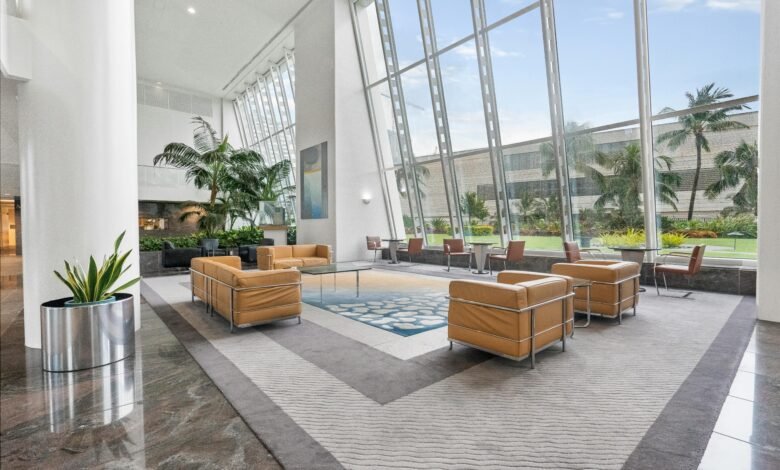The Art of Hospitality: How Hotel Interior Design Shapes Guest Experiences

In the realm of hospitality, the art of hotel interior design plays a crucial role in shaping the guest experience. From the moment a guest steps into a hotel lobby to the comfort of their room, every aspect of the hotel interior design contributes to creating captivating environments that leave a lasting impression. In this article, we delve into how interior design for hotels influences and shapes guest experiences, crafting immersive environments that transform hotel spaces into luxurious retreats.
Crafting Immersive Experiences:
At the heart of hospitality lies the desire to create memorable experiences for guests. Hotel interior design for hotels goes beyond aesthetics; it’s about crafting immersive environments that engage the senses and evoke emotions. From the selection of furnishings to the layout of spaces, every design choice is made with the guest experience in mind. Whether it’s a cozy nook for relaxation or a vibrant communal area for socializing, each space is carefully curated to enhance the overall guest experience.
Creating Captivating Environments:
The design of a hotel sets the stage for the guest’s journey. From the moment they enter the lobby, guests are greeted by a carefully curated atmosphere that reflects the hotel’s brand and identity. The use of lighting, color, and texture creates a sense of warmth and hospitality, inviting guests to explore and unwind. By creating captivating environments, hotels can make a lasting impression and leave guests eager to return.
Transforming Hotel Spaces into Luxurious Retreats:
Luxury hotel interiors are designed to be more than just a place to stay; they are a sanctuary for the senses. From the plush bedding to the indulgent amenities, every detail is thoughtfully curated to create a sense of opulence and comfort. Luxury hotels understand the importance of creating a haven where guests can escape the stresses of everyday life and indulge in a truly immersive experience.
1. Concept of Transformation: This title implies a deliberate effort to change or elevate the existing state of hotel spaces. It suggests a proactive approach to redesigning or enhancing various areas within the hotel to create a new, more upscale atmosphere.
2. Focus on Hotel Spaces: The phrase “hotel spaces” refers to different areas within the hotel, including lobbies, guest rooms, dining areas, spas, and recreational facilities. It indicates that the transformation discussed in the article encompasses a broad range of physical spaces within the hotel property.
3. Luxurious Retreats: “Luxurious retreats” suggests the desired outcome of the transformation process. It implies creating environments that offer guests a sense of opulence, comfort, and relaxation. These spaces are designed to evoke feelings of indulgence and escape from the everyday, providing guests with a memorable and rejuvenating experience.
4. Attention to Detail: Transforming hotel spaces into luxurious retreats involves meticulous attention to detail. This may include upgrading furnishings, selecting high-quality materials, enhancing lighting and ambiance, integrating technology, and incorporating elements of luxury and sophistication throughout the design.
5. Enhancing Guest Experience: Ultimately, the goal of transforming hotel spaces into luxurious retreats is to enhance the overall guest experience. Learn more about our luxury hotel interior designs, where we specialize in creating inviting and upscale environments that surpass guests’ expectations. Our designs not only foster a sense of wellbeing and exclusivity but also cultivate loyalty among discerning travelers who seek exceptional accommodation.
Crafting Personalized Spaces:
In today’s digital age, guests crave personalized experiences that cater to their individual preferences. Interior design for hotels has evolved to include elements of customization and personalization, allowing guests to feel truly at home during their stay. Whether it’s a personalized welcome message or a room tailored to their specific needs, hotels are finding innovative ways to create unique and memorable experiences for every guest.
The Role of Luxury Hotel Interiors:
Luxury hotel interiors are designed to evoke a sense of sophistication and refinement. From opulent furnishings to exquisite artwork, every element is chosen to create an atmosphere of indulgence and exclusivity. Luxury hotels understand the importance of creating a sense of escapism for guests, allowing them to immerse themselves in a world of luxury and elegance.
1. Defining Ambiance: Luxury hotel interiors play a crucial role in defining the ambiance and atmosphere of the hotel. They set the tone for guests’ experiences, whether it’s a sense of opulence and grandeur in a traditional luxury hotel or a modern, minimalist aesthetic in a contemporary boutique hotel.
2. Creating Memorable Experiences: Luxury hotel interiors are designed to create memorable experiences for guests. They aim to evoke emotions, captivate the senses, and leave a lasting impression. From the moment guests step into the lobby to the comfort of their rooms, every aspect of the luxury hotel interiors contributes to the overall guest experience.

3. Reflecting Brand Identity: The interiors of luxury hotels often reflect the brand’s identity and values. Whether it’s a focus on heritage and tradition or a commitment to innovation and modernity, the design elements, color schemes, and furnishings are carefully curated to align with the brand’s image and appeal to its target demographic.
4. Enhancing Comfort and Relaxation: Luxury hotel interiors prioritize guest comfort and relaxation. From sumptuous bedding and plush furnishings to soothing color palettes and ambient lighting, every design choice is made with the goal of providing guests with a tranquil and indulgent retreat from the outside world.
5. Differentiating from Competitors: In a competitive market, luxury hotel interiors serve as a key differentiator. They allow hotels to stand out from the competition and attract discerning travelers seeking exceptional accommodations and experiences. By investing in luxurious and well-appointed interiors, hotels can command higher rates and cultivate a loyal customer base.
Crafting Immersive Experiences in Hotel Interiors:
Immersive experiences are at the core of modern hospitality, and luxury hotel interiors play a crucial role in bringing these experiences to life. Whether it’s through innovative technology or thoughtful design choices, hotels are constantly seeking new ways to engage guests and create unforgettable moments. Click here to see our hotel interior design portfolio to witness firsthand the seamless integration of interactive art installations and virtual reality experiences. From captivating interactive artworks to immersive virtual reality environments, we showcase a myriad of possibilities in crafting unforgettable experiences within hotel interiors.
At the end:
In conclusion, the art of hospitality is intrinsically linked to the art of hotel interior design. By creating captivating environments, crafting immersive experiences, and transforming hotel spaces into luxurious retreats, interior designers have the power to shape the guest experience and leave a lasting impression. Through thoughtful design choices and a focus on guest-centricity, hotels can create truly unforgettable experiences that keep guests coming back time and time again.




